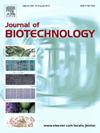在绿色低沸点溶剂中酶法合成芳香族生物基聚合物
IF 4.1
2区 生物学
Q2 BIOTECHNOLOGY & APPLIED MICROBIOLOGY
引用次数: 0
摘要
考虑到不仅在制药、个人护理或电子产品等传统领域,而且在创新研究过程中都需要加快汽油溶剂的替代速度,这项工作重点关注利用四种生物基溶剂作为酶法合成脂肪芳香族聚酯的媒介。木质素衍生的 2,4-吡啶二羧酸二乙酯被选为潜在的生物基芳香族成分,而 1,4-丁二醇和 1,8-辛二醇等传统二元醇则被用作脂肪族部分。结果表明,在测试过的绿色溶剂(环己酮、苯乙醚、苯甲醚和桉叶油醇)中,最适合白色念珠菌脂肪酶 B 催化缩聚反应的介质是桉叶油醇,其单体转化率可达 95%,平均分子量高达 3500 g-mol-1。另一方面,环己酮的单体转化率(80%)和分子量(Mn<500 g-mol-1)最低,这再次证明含酮溶剂不适合酶促酯化和酯交换反应。以桉叶油醇为溶剂,脂肪酶最多可使用三次,而单体转化率和分子量不会显著下降。本文章由计算机程序翻译,如有差异,请以英文原文为准。
Enzymatic synthesis of aromatic biobased polymers in green, low-boiling solvents
Given the urge to accelerate the substitution of petrol-derived solvents not only in more traditional fields like pharmaceuticals, personal care, or electronics but also in innovative research processes, this work focuses on the utilisation of four biobased solvents as media for the enzymatic synthesis of aliphatic-aromatic polyesters. As building blocks, the lignin-derived diethyl-2,4-pyridinedicarboxylate was selected as the potentially biobased, aromatic component while more classical diols such as 1,4-butanediol and 1,8-octanediol were used as the aliphatic portion. Results show that among the tested green solvents (cyclohexanone, phenetole, anisole and eucalyptol), the most suitable medium for lipase B from Candida antarctica-catalysed polycondensation reactions was eucalyptol that allowed reach monomer conversions >95 % and number average molecular weights up to 3500 g·mol−1. On the other hand, cyclohexanone led to the lowest monomer conversions (<80 %) and molecular weights (Mn<500 g·mol−1) confirming once again the unsuitability of ketone-containing solvents for enzymatic esterification and transesterification reactions. The lipase could be used up to three times, in eucalyptol as a solvent, without a significant decrease in monomer conversion or molecular weight.
求助全文
通过发布文献求助,成功后即可免费获取论文全文。
去求助
来源期刊

Journal of biotechnology
工程技术-生物工程与应用微生物
CiteScore
8.90
自引率
2.40%
发文量
190
审稿时长
45 days
期刊介绍:
The Journal of Biotechnology has an open access mirror journal, the Journal of Biotechnology: X, sharing the same aims and scope, editorial team, submission system and rigorous peer review.
The Journal provides a medium for the rapid publication of both full-length articles and short communications on novel and innovative aspects of biotechnology. The Journal will accept papers ranging from genetic or molecular biological positions to those covering biochemical, chemical or bioprocess engineering aspects as well as computer application of new software concepts, provided that in each case the material is directly relevant to biotechnological systems. Papers presenting information of a multidisciplinary nature that would not be suitable for publication in a journal devoted to a single discipline, are particularly welcome.
 求助内容:
求助内容: 应助结果提醒方式:
应助结果提醒方式:


